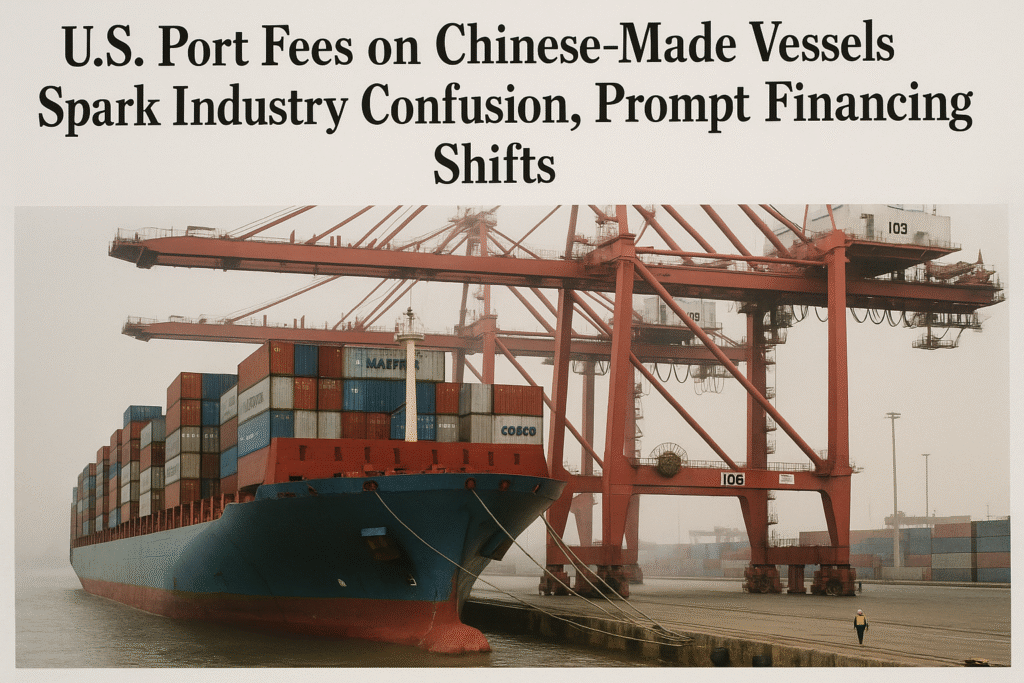By Harshit | October 10, 2025 | New York, 8:45 AM EDT
As U.S. port fees targeting Chinese-made vessels are set to take effect next week, global shipping companies and ocean carriers face widespread uncertainty about how the rules will apply to vessel financing arrangements. The U.S. Trade Representative (USTR) fees could affect ships financed by Chinese lessors, even if the vessels themselves are not owned by Chinese companies, creating a complex financial landscape for the maritime industry.
The new port fees, which begin October 14, require payments before vessels are allowed to enter U.S. ports. They are structured into two categories: one for vessels owned or operated by a Chinese entity and one for Chinese-built ships operated by non-Chinese companies. Fees range from $18 to $50 per net ton of cargo capacity, escalating over time to $140 per net ton by 2028 for the first category, while the second tier caps at $33 per net ton or $250 per container.
James Lightbourn, a shipping financier at Cavalier Shipping, described the industry’s reaction as “confusion.” Many Western shipowners with Chinese lease financing for non-Chinese-built vessels are considering refinancing or restructuring deals to avoid potential exposure to the fees. “Western shipowners who otherwise have no Chinese ownership and who have financed non-Chinese-built vessels with Chinese lessors are indeed looking to refinance or restructure those transactions,” he said.
Chinese financing firms have grown increasingly influential in ship operations, offering sale-and-leaseback (SLB) arrangements, cross-border leases, and other vessel financing solutions. According to Lightbourn, Chinese lessor portfolios account for roughly $100 billion in assets, representing more than 15% of the global ship finance market. This has prompted some European banks, particularly in Greece, to offer more competitive financing to attract shipowners away from Chinese lessors.
Seward & Kissel maritime attorney Brian Maloney noted the legal ambiguity surrounding the fees. “Just because ship financing is not explicitly mentioned in the USTR language does not mean shipowners are exempt,” he said. “Many clients are reviewing their vessel financing agreements and seeking non-Chinese options to mitigate risk.”
The stakes are high: for example, a 13,000 TEU container ship operated by COSCO would incur $3.25 million per port rotation under the first-tier fee structure, totaling over $16 million annually if operating at full capacity. By 2028, annual fees could soar to $45.5 million. Even second-tier fees for non-Chinese carriers operating Chinese-built ships can reach $2 million per rotation, climbing further over time.
In response, some companies are already adjusting operations and financing structures. Greek operator Okeanis Eco Tankers replaced Chinese sale-and-leaseback deals on three VLCCs with non-Chinese bank financing. Similarly, U.S.-flagged carrier Seaspan moved its headquarters from Hong Kong to Singapore and reflagged vessels to mitigate exposure. Japanese banks are also shifting leasing operations to Singapore as China-based deals slow.
Industry experts caution that while transitioning to non-Chinese financing may reduce fee exposure, it can also increase interest costs. “If a shipowner can get as good or better financing outside of China, they should pursue it,” said Lightbourn, “but higher costs could complicate the decision.”
Some exemptions exist. U.S.-owned or flagged vessels in certain maritime programs, small container ships, LNG and specialized chemical tankers, and short-sea shipping vessels under 2,000 nautical miles are not subject to the fees. There is also a potential fee remission for vessels replaced with U.S.-built ships of equivalent size, though domestic shipbuilding capacity for container vessels remains limited.
Peter Sand, chief shipping analyst at Xeneta, highlighted the cost disparity: a Chinese-made vessel may cost around $295 million, whereas a U.S.-built ship could be two to four times more expensive. Despite these challenges, carriers like Maersk have adjusted their operations, rerouting Chinese-built vessels away from U.S. ports to minimize fee exposure without passing the costs onto customers.
The upcoming USTR port fees underscore the growing complexities in global shipping finance. With China controlling over 60% of shipbuilding capacity, carriers face difficult choices balancing cost, compliance, and operational efficiency in a rapidly evolving regulatory environment.







